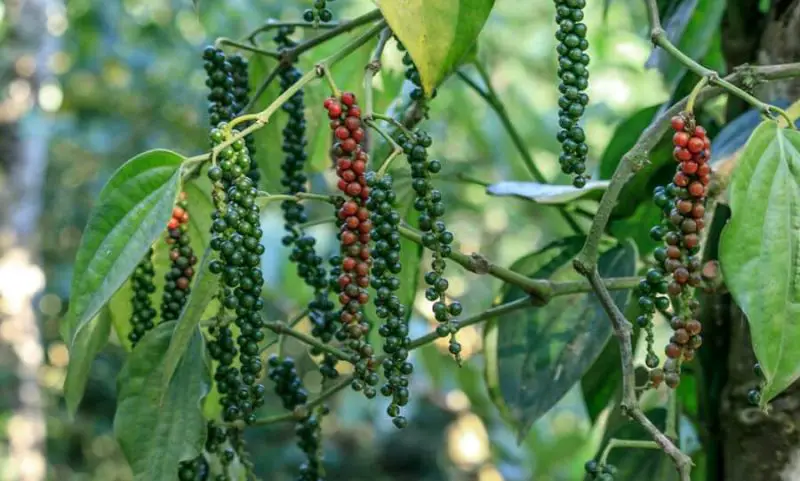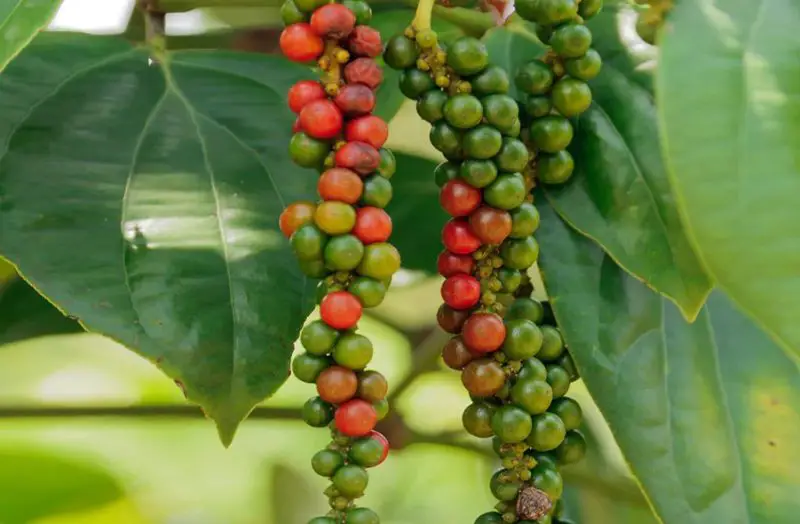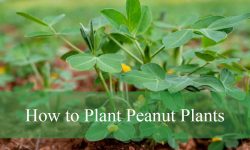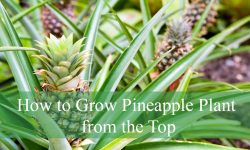The black pepper plant, renowned for its prized peppercorns, holds a special place in the world of culinary delights. Originating from the tropical regions of Asia, this vine not only adds a kick of flavor to dishes but also offers a fascinating gardening experience for enthusiasts. Cultivating black pepper plants requires a nuanced understanding of their unique needs and preferences, from soil composition to environmental conditions.
In this comprehensive guide, we delve into caring for and growing black pepper plants, offering practical advice and insights to help you nurture thriving vines and enjoy a bountiful harvest of flavorful peppercorns.
Whether you’re a seasoned gardener or embarking on your first foray into pepper cultivation, this guide will serve as your indispensable companion on the journey to mastering the art of growing black pepper plants.
Black Pepper Plant Overview

Growing black pepper is a feasible and rewarding endeavor, offering benefits beyond mere cost savings. Peppercorns have a rich history, having been traded between East and West for centuries, known to the ancient Greeks and Romans, and even used as currency in some European countries. This highly valued spice stimulates salivation and gastric juice production, enhancing the flavor of dishes worldwide.
The peppercorn plant, scientifically known as Piper nigrum, is a tropical species cultivated for its black, white, and red peppercorns. The different colors represent various stages of the same fruit. Black peppercorns are dried, immature fruits known for their robust flavor and aroma.
White pepper, on the other hand, is derived from the mature fruit’s inner portion, offering a milder taste. Understanding these stages highlights the versatility and culinary significance of peppercorns, making them an essential ingredient in global cuisine.
Cultivating black pepper can thus connect you to a tradition that spans millennia and continents, enriching your kitchen with a spice celebrated for both its historical importance and culinary excellence.
Growing Black Pepper Plants

Propagation
Black pepper plants are most commonly propagated through vegetative cuttings rather than seeds, ensuring a more reliable growth process. To propagate, take cuttings from healthy, mature plants, making sure each cutting includes nodes that can develop roots. These nodes are essential for successful rooting and subsequent growth.
By using vegetative cuttings, you maintain the genetic consistency of the parent plant, leading to more predictable and vigorous growth compared to seed propagation. This method not only expedites the growth process but also enhances the likelihood of producing strong, healthy pepper plants.
Ideal Conditions
Black pepper plants thrive in tropical climates characterized by high temperatures and humidity. To ensure optimal growth, maintain temperatures between 75-85°F (24-29°C), as the plants will cease growing if temperatures drop below 65°F (18°C) and they cannot tolerate frost. Plant black pepper in a location that receives partial shade to full sun to mimic its natural environment.
For those in non-tropical regions, growing the plants in a greenhouse or indoors can provide the necessary warmth and humidity. Creating these ideal conditions is crucial for the healthy development and productivity of black pepper plants.
Soil Requirements
For optimal growth, black pepper plants require specific soil conditions:
Type: Utilize well-draining, rich, loamy soil to provide the ideal foundation for your black pepper plants. This type of soil allows for adequate water drainage while retaining essential nutrients necessary for plant health and growth.
pH: Maintain the soil pH within the range of 5.5 to 7, as this acidic to neutral range promotes optimal nutrient uptake by the plants. Adding organic matter, such as compost, can further enhance soil quality and drainage, ensuring that the black pepper plants receive the necessary nutrients for vigorous growth and development. By meeting these soil requirements, you can create an environment conducive to the successful cultivation of black pepper plants.
Caring for Black Pepper Plants
Watering
Proper watering is essential for the health and vitality of black pepper plants. Follow these guidelines for effective watering:
Frequency: Water the plants thoroughly and consistently to ensure they receive an adequate supply of moisture. It’s crucial to maintain soil moisture levels to keep the plants healthy and thriving. However, avoid waterlogging the soil, as excessive moisture can lead to root rot.
Avoiding Issues: Strike a balance between watering enough to keep the soil moist and preventing it from drying out completely. Overwatering can suffocate the roots and promote the development of root rot, while underwatering can stress the plants and inhibit growth. Regularly check the soil moisture levels and adjust your watering routine accordingly to maintain optimal conditions for your black pepper plants. With proper watering practices, you can help ensure the long-term health and productivity of your plants.
Fertilization
To promote healthy growth and robust pepper production, proper fertilization is essential. Follow these guidelines for effective fertilization:
Type: Use a balanced 10-10-10 fertilizer to provide the necessary nutrients for your black pepper plants. This balanced formula ensures that the plants receive a well-rounded supply of essential elements for optimal growth and development.
Schedule: Dilute ¼ teaspoon (5 mL) of fertilizer in a gallon (4 L) of water and apply the solution every one to two weeks during the growing season. This regular feeding schedule provides a consistent supply of nutrients to support the plants’ needs and encourages vigorous growth.
Winter Maintenance: During the winter months, suspend fertilization to coincide with the plants’ natural dormancy period. This allows the plants to rest and conserve energy without the added stress of nutrient uptake. Resume fertilization in the spring as the plants begin to resume active growth.
Humidity
Maintaining adequate humidity levels is crucial for the optimal growth and health of black pepper plants. Follow these guidelines to meet the humidity requirements of your plants:
Requirements: Black pepper plants thrive in environments with high humidity levels, ideally above 50%. Adequate humidity helps to prevent moisture loss from the plants’ leaves and promotes healthy growth.
Increasing Humidity: In dry environments or during periods of low humidity, it may be necessary to increase the moisture levels around your black pepper plants. One effective method is through regular misting, where you spray a fine mist of water over the foliage to create a humid microclimate around the plants.
Using Humidity Trays: Another option is to use humidity trays or saucers filled with water placed near the plants. As the water evaporates, it increases the humidity in the surrounding air, providing the necessary moisture for the plants.
Light and Placement
Providing the right amount and type of light is crucial for the healthy growth of black pepper plants. Here’s what you need to know about light and placement:
Light: Black pepper plants thrive in bright, indirect light. While they can tolerate full sun if humidity levels are adequate, it’s essential to avoid direct sunlight, which can scorch the leaves. Place your plants in a location where they receive bright, filtered sunlight throughout the day.
Indoor Growing: When growing black pepper plants indoors, ensure they receive sufficient light by placing them near a bright window. Supplemental lighting, such as grow lights, may be necessary, especially during the darker winter months or if natural light is limited. Position the grow lights above the plants to mimic the intensity and spectrum of natural sunlight.
Pruning and Training
To maintain the health and vigor of your black pepper plants, it’s important to practice proper pruning and training techniques:
Pruning: Regular pruning is essential for removing dead or yellowing leaves and shaping the plant. This not only enhances the plant’s appearance but also encourages bushier growth and improves air circulation around the foliage. Pruning also helps to remove any diseased or damaged parts of the plant, promoting overall plant health and vitality.
Training: Black pepper plants are climbing vines that benefit from support to guide their growth. Use a trellis or stake to provide support for the vines and help manage their growth direction. Training the vines also facilitates better light exposure, ensuring that all parts of the plant receive adequate sunlight for photosynthesis. Proper training helps prevent overcrowding and allows for efficient use of growing space.
Pest and Disease Management
To keep your black pepper plants healthy and thriving, it’s crucial to implement effective pest and disease management strategies:
Pests: Regularly monitor your plants for common pests such as aphids, spider mites, and mealybugs. These pests can damage foliage and affect plant health if left unchecked. If you notice signs of infestation, promptly treat the affected plants with insecticidal soap or neem oil. These organic solutions effectively control pests while minimizing harm to beneficial insects and the environment.
Diseases: Proper care and maintenance can help prevent fungal diseases that may affect black pepper plants. Ensure good air circulation around the plants by spacing them appropriately and avoiding overcrowding. Additionally, avoid overhead watering, as wet foliage can create a favorable environment for fungal growth. If you notice any signs of disease, such as leaf spots or moldy growth, remove infected plant parts promptly to prevent the spread of the disease to healthy plants.
Stimulating Peppercorn Production
To encourage robust flowering and peppercorn production in your black pepper plants, it’s important to create the right environment and exercise patience:
Environment: Provide your black pepper plants with bright, indirect light to simulate their natural tropical habitat. Additionally, maintain temperatures above 65°F (18°C), as cooler temperatures can inhibit flowering and fruiting. By optimizing these environmental conditions, you can stimulate the plants to initiate flowering and set fruit, leading to a bountiful harvest of peppercorns.
Patience: It’s essential to understand that black pepper plants are slow-growing and may take several years to reach maturity and produce flowers and peppercorns. During this time, it’s important to provide consistent care and maintain optimal conditions to support the plants’ growth and development. While it may require patience to see results, the reward of freshly harvested peppercorns will be well worth the wait.
Conclusion
Growing and caring for black pepper plants require attention to their specific needs, including a warm and humid environment, well-draining soil, consistent watering, and balanced fertilization. By providing these conditions and practicing regular maintenance, you can enjoy the rewarding experience of cultivating black pepper plants and eventually harvesting your own peppercorns.






